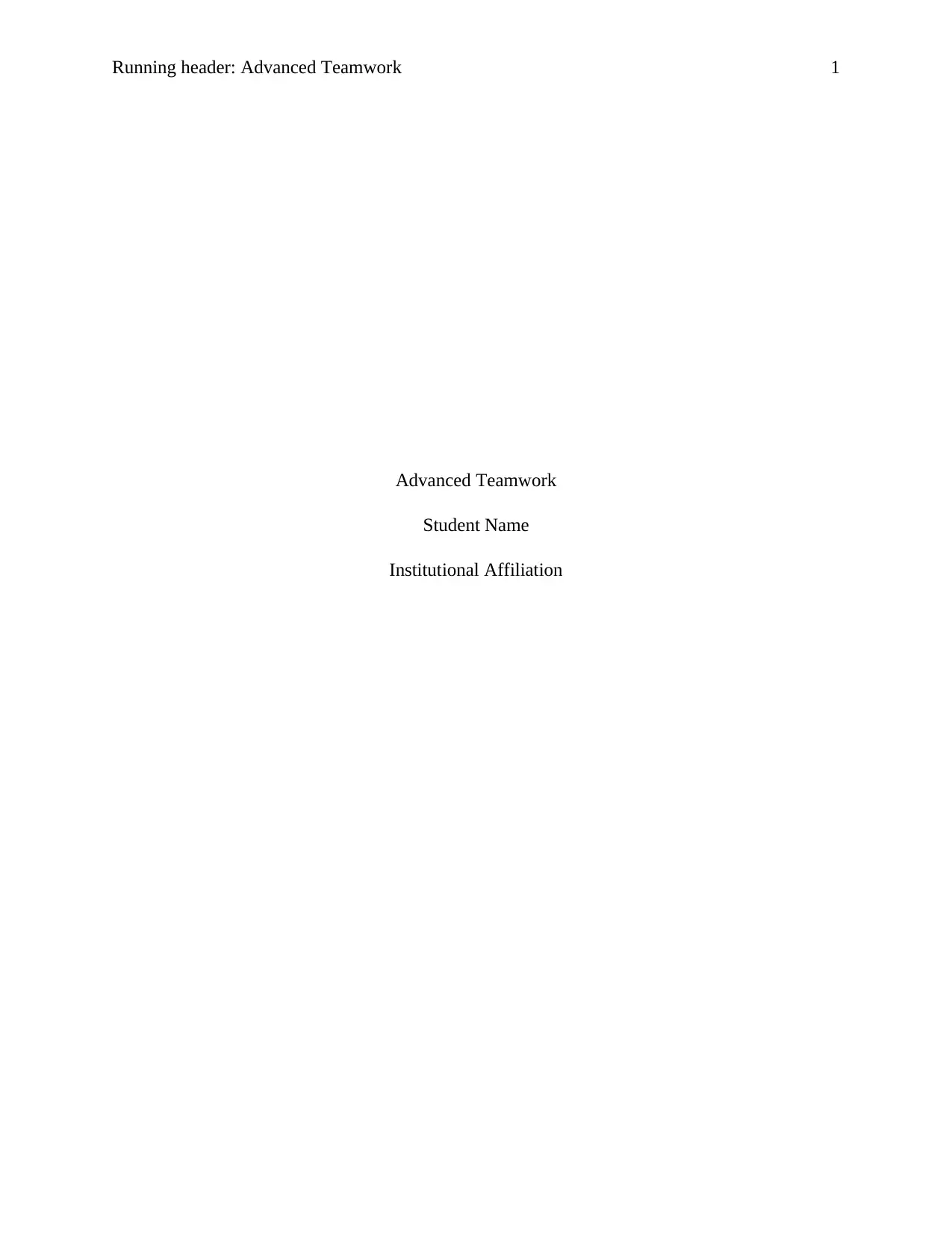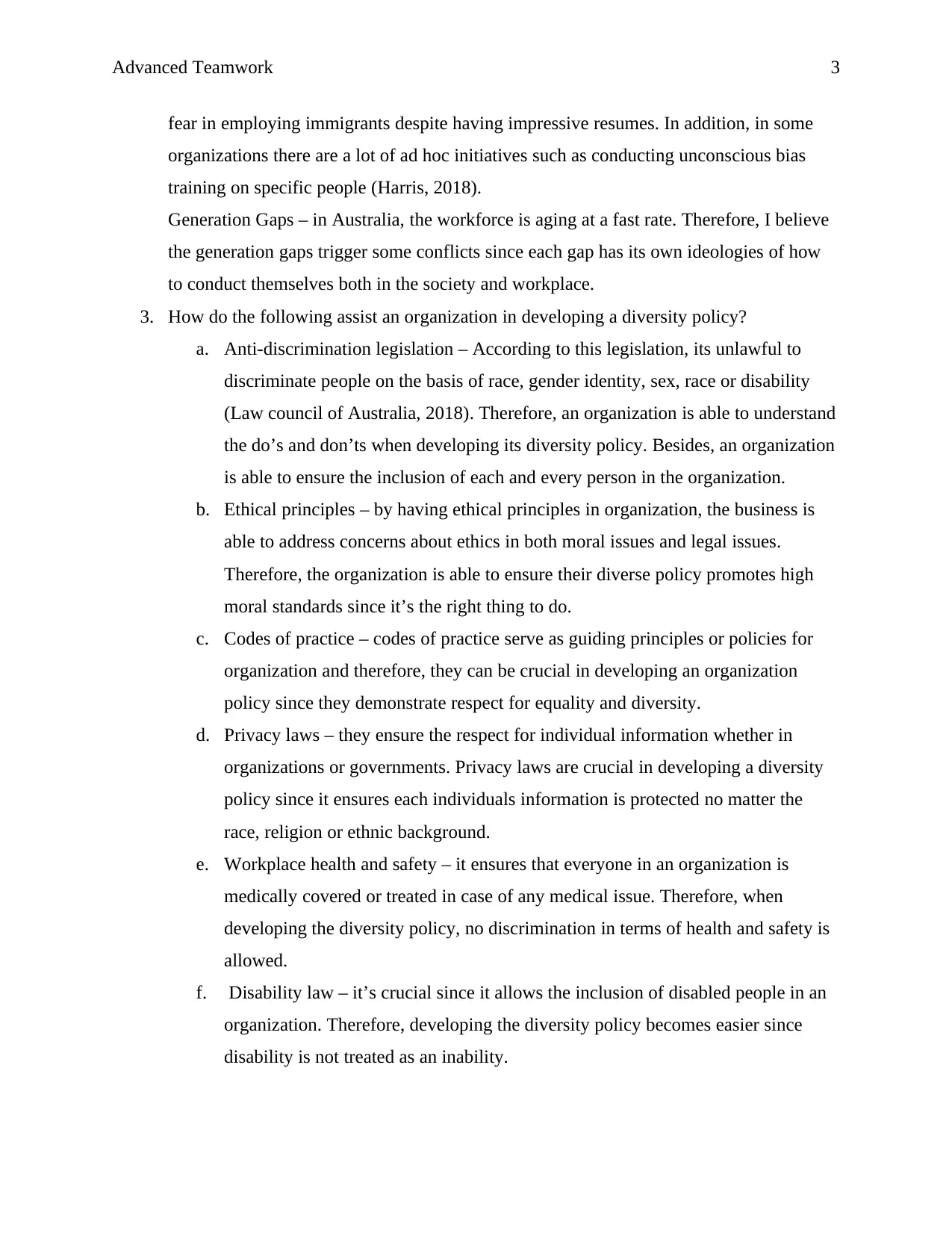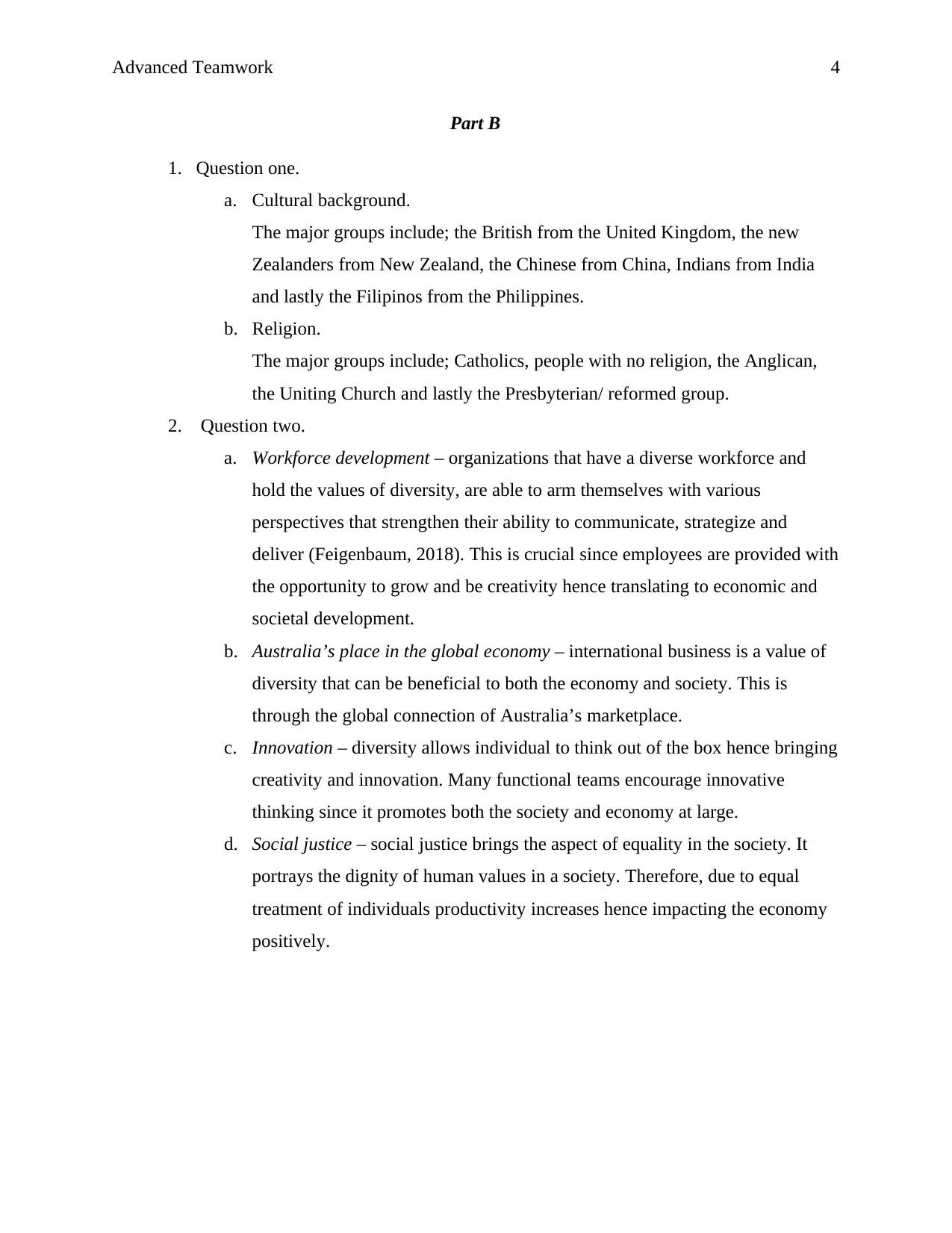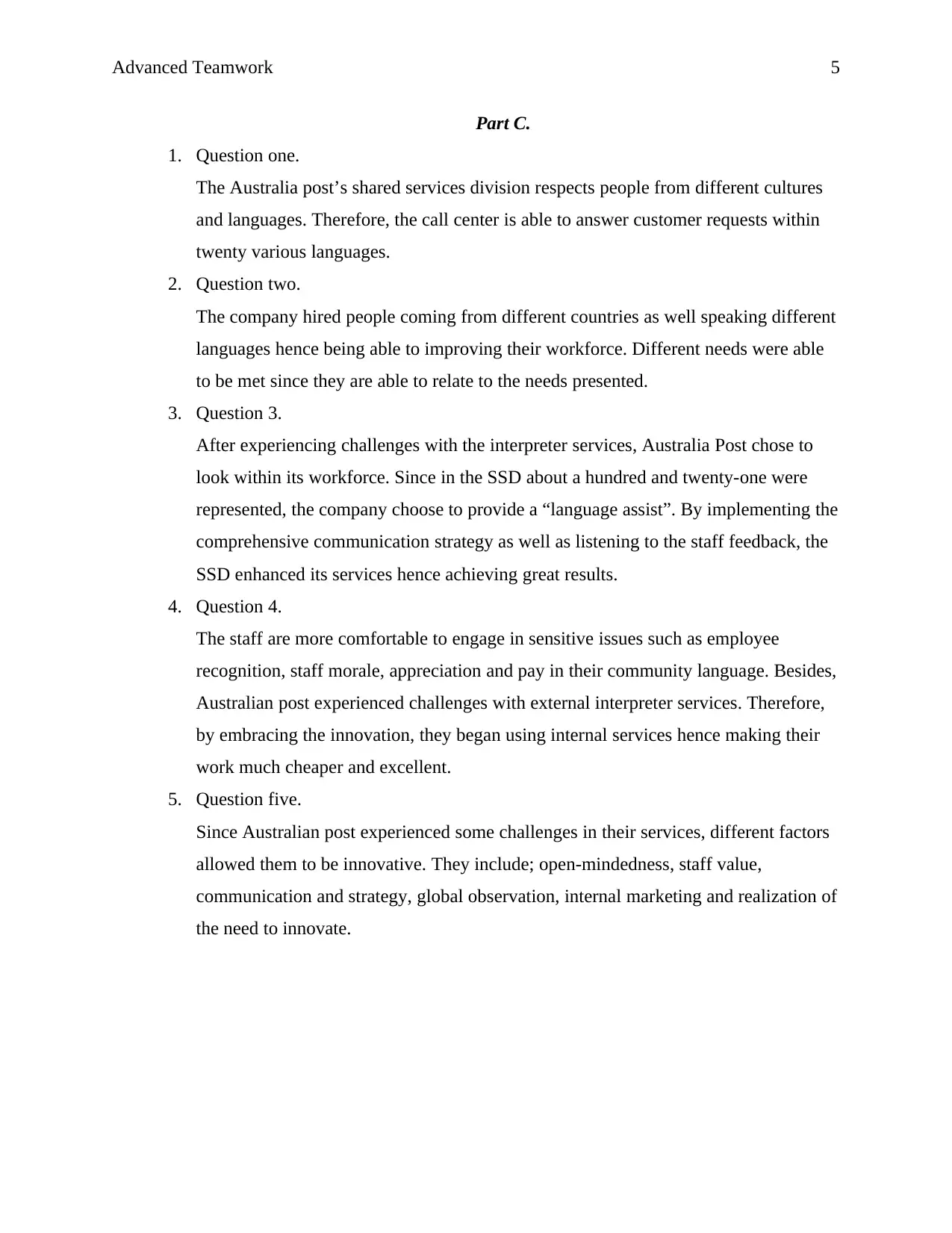Advanced Teamwork Report: Diversity, Inclusion in Australian Society
VerifiedAdded on 2021/12/08
|6
|1472
|83
Report
AI Summary
This report, focusing on advanced teamwork, delves into the critical aspects of workplace diversity and inclusion within the Australian context. It examines strategies for ensuring that customer and client relations value diversity, emphasizing the avoidance of racism and age discrimination, and promoting respect for all cultures. The report identifies key diversity issues relevant to modern Australian society, including ethnic and cultural differences, acceptance and respect for migrants, and generation gaps. It further explores how anti-discrimination legislation, ethical principles, codes of practice, privacy laws, workplace health and safety, and disability law assist organizations in developing effective diversity policies. The report also highlights the benefits of a diverse workforce, such as workforce development, Australia's place in the global economy, innovation, and social justice. Through case studies like Australia Post, the report showcases practical examples of successful diversity initiatives and their positive impacts on both internal operations and external customer service. The analysis incorporates references to relevant legislation, ethical guidelines, and research findings to provide a comprehensive understanding of the subject.

Running header: Advanced Teamwork 1
Advanced Teamwork
Student Name
Institutional Affiliation
Advanced Teamwork
Student Name
Institutional Affiliation
Paraphrase This Document
Need a fresh take? Get an instant paraphrase of this document with our AI Paraphraser

Advanced Teamwork 2
Part A
1. How would you ensure that relations with customers and clients demonstrate that
diversity is valued by your own business?
Avoiding racism – In many legislations around the world, racial discrimination is
considered illegal since its demining (Banton, 2018). However, in my business, I would
avoid and eliminate prejudices and stereotypes by focusing on the value and qualities of
each customer or client. I’ll would avoid assumptions about people and where they come
from and try to respect and appreciate every race represented by the either the customer
or client. This would increase more lively interactions within the business.
Treat customers how would want to be treated – This one of the so called “Golden rule”.
I would as much ensure my employees are considerate and sensitive to the expectations
and boundaries of customers and clients. I would try as much to ensure all cultures are
respected as well as honored. I would go further to ensure that I and my employees
understand how different cultures perceive different aspects such as handshakes, eye
contacts and personal space. I would also ensure my workplace is welcoming and
productive to both clients, customers and other parties.
Avoiding age discrimination – Conflicts at times arise due to lack of acknowledging
opinions and values of different parties (Aspire training and counselling, 2018). I would
ensure all clients whether young or old are treated with much respect and their opinions
are highly valued. Besides, since Australia’s population is ageing and the workforce has
more older people, I would ensure they are equally recognized effectively. For example, I
would appreciate the opinions and guidance given by old people. I would also be open to
correction and mentorship by experienced clients or customers.
2. What diversity issues do you think are relevant to modern Australian society?
Ethnic and cultural differences – In Australia, migrants make enormous contributions to
the economy (Australian Human Rights, 2018). Besides, one in every ten Australians
believe that specific races are superior to others. Discrimination because of skin color is
prevalent from neighborhoods, shopping centers, and at work. In addition, migrants face
hurdles in their fast jobs. I think this is an unresolved diversity issue in Australia.
Acceptance and respect – Lack of acceptance of new migrants into the workplace has
been an issue. In some workplaces, I believe there is no work diversity. There is a general
Part A
1. How would you ensure that relations with customers and clients demonstrate that
diversity is valued by your own business?
Avoiding racism – In many legislations around the world, racial discrimination is
considered illegal since its demining (Banton, 2018). However, in my business, I would
avoid and eliminate prejudices and stereotypes by focusing on the value and qualities of
each customer or client. I’ll would avoid assumptions about people and where they come
from and try to respect and appreciate every race represented by the either the customer
or client. This would increase more lively interactions within the business.
Treat customers how would want to be treated – This one of the so called “Golden rule”.
I would as much ensure my employees are considerate and sensitive to the expectations
and boundaries of customers and clients. I would try as much to ensure all cultures are
respected as well as honored. I would go further to ensure that I and my employees
understand how different cultures perceive different aspects such as handshakes, eye
contacts and personal space. I would also ensure my workplace is welcoming and
productive to both clients, customers and other parties.
Avoiding age discrimination – Conflicts at times arise due to lack of acknowledging
opinions and values of different parties (Aspire training and counselling, 2018). I would
ensure all clients whether young or old are treated with much respect and their opinions
are highly valued. Besides, since Australia’s population is ageing and the workforce has
more older people, I would ensure they are equally recognized effectively. For example, I
would appreciate the opinions and guidance given by old people. I would also be open to
correction and mentorship by experienced clients or customers.
2. What diversity issues do you think are relevant to modern Australian society?
Ethnic and cultural differences – In Australia, migrants make enormous contributions to
the economy (Australian Human Rights, 2018). Besides, one in every ten Australians
believe that specific races are superior to others. Discrimination because of skin color is
prevalent from neighborhoods, shopping centers, and at work. In addition, migrants face
hurdles in their fast jobs. I think this is an unresolved diversity issue in Australia.
Acceptance and respect – Lack of acceptance of new migrants into the workplace has
been an issue. In some workplaces, I believe there is no work diversity. There is a general

Advanced Teamwork 3
fear in employing immigrants despite having impressive resumes. In addition, in some
organizations there are a lot of ad hoc initiatives such as conducting unconscious bias
training on specific people (Harris, 2018).
Generation Gaps – in Australia, the workforce is aging at a fast rate. Therefore, I believe
the generation gaps trigger some conflicts since each gap has its own ideologies of how
to conduct themselves both in the society and workplace.
3. How do the following assist an organization in developing a diversity policy?
a. Anti-discrimination legislation – According to this legislation, its unlawful to
discriminate people on the basis of race, gender identity, sex, race or disability
(Law council of Australia, 2018). Therefore, an organization is able to understand
the do’s and don’ts when developing its diversity policy. Besides, an organization
is able to ensure the inclusion of each and every person in the organization.
b. Ethical principles – by having ethical principles in organization, the business is
able to address concerns about ethics in both moral issues and legal issues.
Therefore, the organization is able to ensure their diverse policy promotes high
moral standards since it’s the right thing to do.
c. Codes of practice – codes of practice serve as guiding principles or policies for
organization and therefore, they can be crucial in developing an organization
policy since they demonstrate respect for equality and diversity.
d. Privacy laws – they ensure the respect for individual information whether in
organizations or governments. Privacy laws are crucial in developing a diversity
policy since it ensures each individuals information is protected no matter the
race, religion or ethnic background.
e. Workplace health and safety – it ensures that everyone in an organization is
medically covered or treated in case of any medical issue. Therefore, when
developing the diversity policy, no discrimination in terms of health and safety is
allowed.
f. Disability law – it’s crucial since it allows the inclusion of disabled people in an
organization. Therefore, developing the diversity policy becomes easier since
disability is not treated as an inability.
fear in employing immigrants despite having impressive resumes. In addition, in some
organizations there are a lot of ad hoc initiatives such as conducting unconscious bias
training on specific people (Harris, 2018).
Generation Gaps – in Australia, the workforce is aging at a fast rate. Therefore, I believe
the generation gaps trigger some conflicts since each gap has its own ideologies of how
to conduct themselves both in the society and workplace.
3. How do the following assist an organization in developing a diversity policy?
a. Anti-discrimination legislation – According to this legislation, its unlawful to
discriminate people on the basis of race, gender identity, sex, race or disability
(Law council of Australia, 2018). Therefore, an organization is able to understand
the do’s and don’ts when developing its diversity policy. Besides, an organization
is able to ensure the inclusion of each and every person in the organization.
b. Ethical principles – by having ethical principles in organization, the business is
able to address concerns about ethics in both moral issues and legal issues.
Therefore, the organization is able to ensure their diverse policy promotes high
moral standards since it’s the right thing to do.
c. Codes of practice – codes of practice serve as guiding principles or policies for
organization and therefore, they can be crucial in developing an organization
policy since they demonstrate respect for equality and diversity.
d. Privacy laws – they ensure the respect for individual information whether in
organizations or governments. Privacy laws are crucial in developing a diversity
policy since it ensures each individuals information is protected no matter the
race, religion or ethnic background.
e. Workplace health and safety – it ensures that everyone in an organization is
medically covered or treated in case of any medical issue. Therefore, when
developing the diversity policy, no discrimination in terms of health and safety is
allowed.
f. Disability law – it’s crucial since it allows the inclusion of disabled people in an
organization. Therefore, developing the diversity policy becomes easier since
disability is not treated as an inability.
⊘ This is a preview!⊘
Do you want full access?
Subscribe today to unlock all pages.

Trusted by 1+ million students worldwide

Advanced Teamwork 4
Part B
1. Question one.
a. Cultural background.
The major groups include; the British from the United Kingdom, the new
Zealanders from New Zealand, the Chinese from China, Indians from India
and lastly the Filipinos from the Philippines.
b. Religion.
The major groups include; Catholics, people with no religion, the Anglican,
the Uniting Church and lastly the Presbyterian/ reformed group.
2. Question two.
a. Workforce development – organizations that have a diverse workforce and
hold the values of diversity, are able to arm themselves with various
perspectives that strengthen their ability to communicate, strategize and
deliver (Feigenbaum, 2018). This is crucial since employees are provided with
the opportunity to grow and be creativity hence translating to economic and
societal development.
b. Australia’s place in the global economy – international business is a value of
diversity that can be beneficial to both the economy and society. This is
through the global connection of Australia’s marketplace.
c. Innovation – diversity allows individual to think out of the box hence bringing
creativity and innovation. Many functional teams encourage innovative
thinking since it promotes both the society and economy at large.
d. Social justice – social justice brings the aspect of equality in the society. It
portrays the dignity of human values in a society. Therefore, due to equal
treatment of individuals productivity increases hence impacting the economy
positively.
Part B
1. Question one.
a. Cultural background.
The major groups include; the British from the United Kingdom, the new
Zealanders from New Zealand, the Chinese from China, Indians from India
and lastly the Filipinos from the Philippines.
b. Religion.
The major groups include; Catholics, people with no religion, the Anglican,
the Uniting Church and lastly the Presbyterian/ reformed group.
2. Question two.
a. Workforce development – organizations that have a diverse workforce and
hold the values of diversity, are able to arm themselves with various
perspectives that strengthen their ability to communicate, strategize and
deliver (Feigenbaum, 2018). This is crucial since employees are provided with
the opportunity to grow and be creativity hence translating to economic and
societal development.
b. Australia’s place in the global economy – international business is a value of
diversity that can be beneficial to both the economy and society. This is
through the global connection of Australia’s marketplace.
c. Innovation – diversity allows individual to think out of the box hence bringing
creativity and innovation. Many functional teams encourage innovative
thinking since it promotes both the society and economy at large.
d. Social justice – social justice brings the aspect of equality in the society. It
portrays the dignity of human values in a society. Therefore, due to equal
treatment of individuals productivity increases hence impacting the economy
positively.
Paraphrase This Document
Need a fresh take? Get an instant paraphrase of this document with our AI Paraphraser

Advanced Teamwork 5
Part C.
1. Question one.
The Australia post’s shared services division respects people from different cultures
and languages. Therefore, the call center is able to answer customer requests within
twenty various languages.
2. Question two.
The company hired people coming from different countries as well speaking different
languages hence being able to improving their workforce. Different needs were able
to be met since they are able to relate to the needs presented.
3. Question 3.
After experiencing challenges with the interpreter services, Australia Post chose to
look within its workforce. Since in the SSD about a hundred and twenty-one were
represented, the company choose to provide a “language assist”. By implementing the
comprehensive communication strategy as well as listening to the staff feedback, the
SSD enhanced its services hence achieving great results.
4. Question 4.
The staff are more comfortable to engage in sensitive issues such as employee
recognition, staff morale, appreciation and pay in their community language. Besides,
Australian post experienced challenges with external interpreter services. Therefore,
by embracing the innovation, they began using internal services hence making their
work much cheaper and excellent.
5. Question five.
Since Australian post experienced some challenges in their services, different factors
allowed them to be innovative. They include; open-mindedness, staff value,
communication and strategy, global observation, internal marketing and realization of
the need to innovate.
Part C.
1. Question one.
The Australia post’s shared services division respects people from different cultures
and languages. Therefore, the call center is able to answer customer requests within
twenty various languages.
2. Question two.
The company hired people coming from different countries as well speaking different
languages hence being able to improving their workforce. Different needs were able
to be met since they are able to relate to the needs presented.
3. Question 3.
After experiencing challenges with the interpreter services, Australia Post chose to
look within its workforce. Since in the SSD about a hundred and twenty-one were
represented, the company choose to provide a “language assist”. By implementing the
comprehensive communication strategy as well as listening to the staff feedback, the
SSD enhanced its services hence achieving great results.
4. Question 4.
The staff are more comfortable to engage in sensitive issues such as employee
recognition, staff morale, appreciation and pay in their community language. Besides,
Australian post experienced challenges with external interpreter services. Therefore,
by embracing the innovation, they began using internal services hence making their
work much cheaper and excellent.
5. Question five.
Since Australian post experienced some challenges in their services, different factors
allowed them to be innovative. They include; open-mindedness, staff value,
communication and strategy, global observation, internal marketing and realization of
the need to innovate.

Advanced Teamwork 6
References
Aspire training and counselling. (2018). Work effectively with diversity. Retrieved from
https://aspire-solidus-production.s3-ap-southeast-2.amazonaws.com/assets/BXDIV301/
samples/BXDIV301.pdf
Australian Human Rights. (2018). Face the facts: Cultural Diversity. Retrieved from
https://www.humanrights.gov.au/face-facts-cultural-diversity
Banton, M. (2018). The concept of racism. In Race and racialism (pp. 17-34). Routledge.
Feigenbaum, E. (2018). The Value of Diversity in the Workplace. Retrieved from
https://smallbusiness.chron.com/value-diversity-workplace-3035.html
Harris, L. (2018). Most Australian workplaces are failing to achieve diversity: study. Retrieved
from https://www.sbs.com.au/news/most-australian-workplaces-are-failing-to-achieve-
diversity-study
Law council of Australia. (2018). Anti-discrimination laws. Retrieved from
https://www.lawcouncil.asn.au/policy-agenda/human-rights/anti-discrimination-laws
References
Aspire training and counselling. (2018). Work effectively with diversity. Retrieved from
https://aspire-solidus-production.s3-ap-southeast-2.amazonaws.com/assets/BXDIV301/
samples/BXDIV301.pdf
Australian Human Rights. (2018). Face the facts: Cultural Diversity. Retrieved from
https://www.humanrights.gov.au/face-facts-cultural-diversity
Banton, M. (2018). The concept of racism. In Race and racialism (pp. 17-34). Routledge.
Feigenbaum, E. (2018). The Value of Diversity in the Workplace. Retrieved from
https://smallbusiness.chron.com/value-diversity-workplace-3035.html
Harris, L. (2018). Most Australian workplaces are failing to achieve diversity: study. Retrieved
from https://www.sbs.com.au/news/most-australian-workplaces-are-failing-to-achieve-
diversity-study
Law council of Australia. (2018). Anti-discrimination laws. Retrieved from
https://www.lawcouncil.asn.au/policy-agenda/human-rights/anti-discrimination-laws
⊘ This is a preview!⊘
Do you want full access?
Subscribe today to unlock all pages.

Trusted by 1+ million students worldwide
1 out of 6
Related Documents
Your All-in-One AI-Powered Toolkit for Academic Success.
+13062052269
info@desklib.com
Available 24*7 on WhatsApp / Email
![[object Object]](/_next/static/media/star-bottom.7253800d.svg)
Unlock your academic potential
Copyright © 2020–2025 A2Z Services. All Rights Reserved. Developed and managed by ZUCOL.





